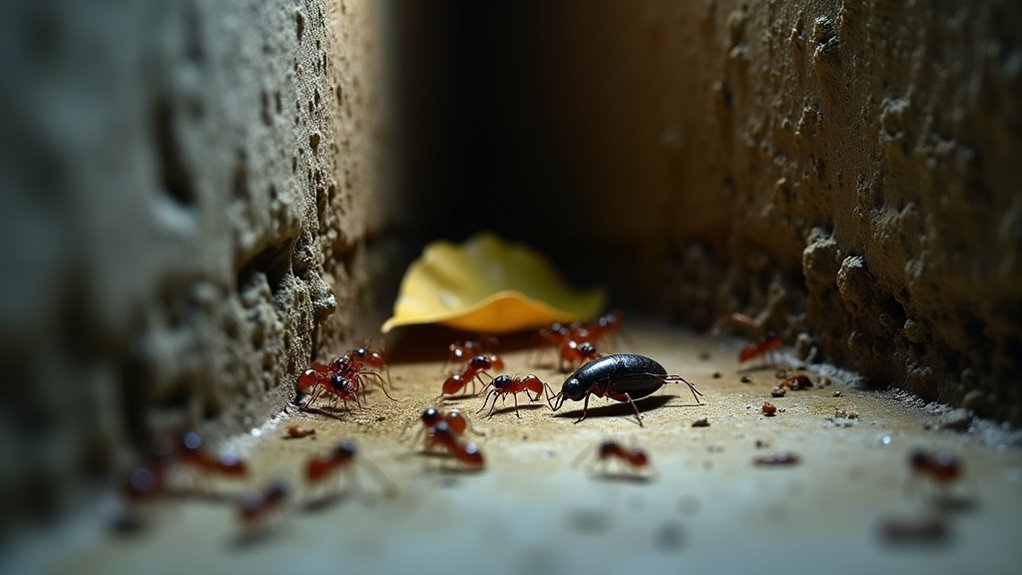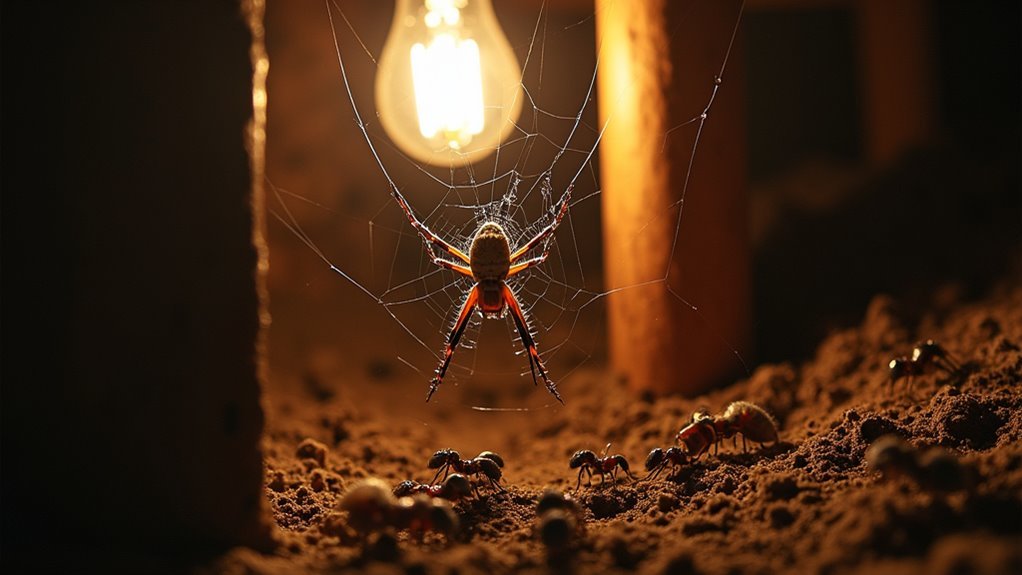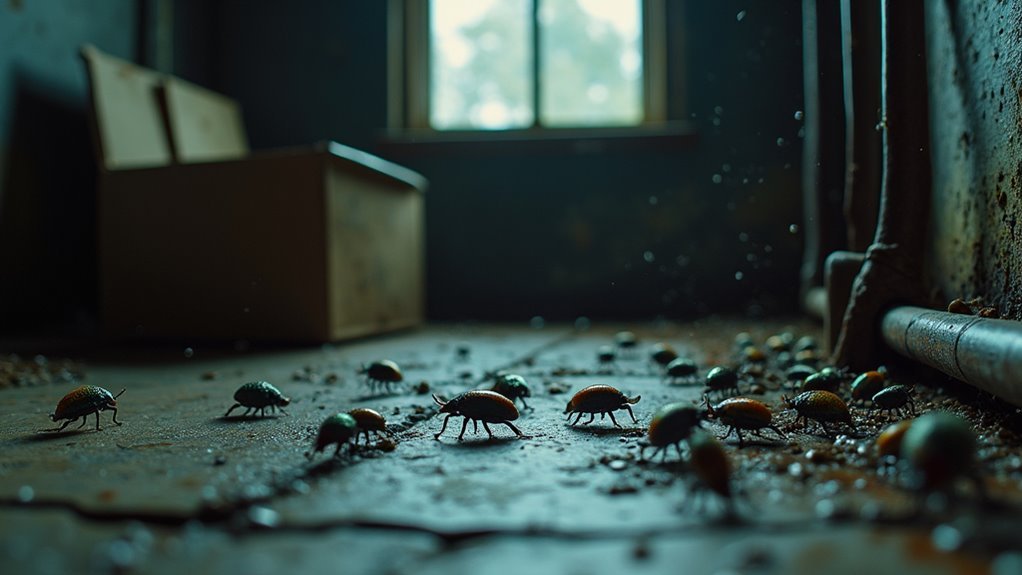Basement bugs invade in every season because your underground space provides exactly what they need year-round: stable temperatures, consistent moisture, and protected shelter. Spring brings cockroaches and ants seeking humidity, summer heat drives insects downward for cooler conditions, fall sends pests searching for warm overwintering spots, and winter’s harsh conditions make your heated basement irresistible. Your basement maintains ideal pest conditions regardless of outdoor weather, creating a perfect sanctuary that attracts different species throughout each season’s unique challenges.
Understanding the Seasonal Nature of Basement Pest Activity

While many homeowners assume pest problems diminish during colder months, basement invaders actually follow distinct seasonal patterns that can catch you off guard year-round. Your basement pests don’t simply disappear when temperatures drop—they adapt their behavior based on environmental conditions.
During spring and summer, cockroaches and silverfish thrive as rising moisture levels create perfect breeding conditions in your warm, humid basement. These seasonal activity patterns intensify when humidity peaks, making your basement irresistible to insects seeking ideal reproductive environments.
As fall and winter arrive, different challenges emerge. Cold-seeking pests view your basement as prime real estate for overwintering, leading to increased indoor activity precisely when you’re least prepared.
Understanding these predictable cycles helps you anticipate invasions and implement targeted prevention strategies throughout each season.
Spring Pest Emergence and Early Detection Strategies
As spring temperatures rise, you’ll notice cockroaches and ants emerging from their winter hideouts, seeking moisture and food in your basement.
You can catch these infestations early by watching for telltale signs like droppings, shed skins, and small nests during regular inspections.
Your best defense involves combining proactive monitoring with immediate action when you spot the first warning signs of pest activity.
Spring Awakening Patterns
When spring temperatures begin to climb, your basement becomes a prime target for emerging pests who’ve spent the winter months tucked away in dark crevices and hidden corners. These unwelcome visitors awaken with increased appetites and breeding instincts, making your damp basement an attractive destination.
You’ll notice specific patterns as different pests emerge at varying temperature thresholds. Early pest control starts with understanding these awakening cycles and identifying potential entry points like cracks and gaps in your foundation.
| Basement Bug | Emergence Temperature | Activity Level | Preferred Areas | Detection Signs |
|---|---|---|---|---|
| Cockroaches | 50-60°F | High | Near water sources | Droppings, egg cases |
| Ants | 45-55°F | Moderate | Food storage areas | Trails, scattered crumbs |
| Silverfish | 55-65°F | Low-Moderate | Paper/fabric storage | Holes in materials |
| Centipedes | 60-70°F | High | Damp corners | Shed skin |
| Spiders | 40-50°F | Variable | Web-friendly spaces | Webs, egg sacs |
Early Warning Signs
Since spring’s arrival triggers basement pest activity, you’ll want to catch these invaders before they establish colonies. Start by scanning for early warning signs like dead insects, droppings, and nesting materials scattered throughout your basement. These telltale indicators reveal active infestations that demand immediate attention.
Focus your inspection on stored items, particularly those containing cardboard and wood. Pests gravitate toward these organic materials for both shelter and sustenance. Deploy traps and sticky boards strategically to monitor pest activity levels and identify problem areas before situations escalate.
Don’t overlook potential entry points around your basement perimeter. Examine walls and windows carefully for cracks and gaps where cockroaches and silverfish might squeeze through. These vulnerable spots become highways for moisture-seeking pests emerging from winter hideouts.
Proactive Monitoring Methods
While early detection remains your best defense against basement invasions, implementing systematic monitoring methods transforms reactive pest control into proactive protection.
You’ll catch emerging problems before they become full-scale infestations by establishing consistent surveillance routines.
Your proactive monitoring strategy should include:
- Sticky trap placement in corners and along walls during spring to detect ants and cockroaches early
- Regular moisture entry points inspections to identify damp conditions that attract pests year-round
- Humidity monitoring with a hygrometer, maintaining 30-50% relative humidity levels
- Seasonal cleaning schedules to eliminate hiding spots through decluttering
Schedule professional pest inspections each early spring to complement your monitoring efforts.
This combination of personal vigilance and expert assessment creates a thorough defense system that prevents minor pest issues from escalating into major basement invasions.
Summer Heat Drives Insects Into Cool Basement Spaces
When summer temperatures soar, you’ll notice insects abandoning the scorching outdoors for your basement’s naturally cool environment.
Your underground space becomes a magnet for heat-stressed pests like cockroaches, silverfish, ants, and spiders who desperately seek temperature relief from the sweltering conditions above.
The combination of your basement’s consistent coolness, available moisture, and shadowy corners creates an irresistible refuge that attracts these unwanted visitors throughout the hottest months.
Temperature Relief Seeking Behavior
As summer temperatures climb beyond comfortable levels, insects instinctively migrate toward the coolest available shelter they can find—often your basement.
This temperature relief seeking behavior drives bugs to abandon their usual outdoor habitats when heat exceeds their tolerance thresholds. Your basement’s consistently lower temperature creates an irresistible refuge that attracts various pests seeking immediate relief from scorching conditions.
The combination of cooler air and elevated humidity levels makes basements particularly appealing to insects during peak summer months.
Here’s what draws them downstairs:
- Temperature differential – Basements stay 10-20 degrees cooler than outdoor areas
- Moisture availability – Higher humidity provides essential hydration sources
- Consistent conditions – Stable environment without temperature fluctuations
- Easy access – Multiple entry points through cracks and gaps
Cool Underground Environment Appeal
Beyond just seeking temporary temperature relief, insects actively choose basements because they replicate their preferred natural underground habitats.
Your basement’s subterranean location provides the consistent cool temperatures and sheltered environment that many pests naturally gravitate toward. The lower light levels found underground appeal to insects that avoid bright sunlight and prefer darker spaces for survival.
During summer heat waves, this underground appeal becomes even stronger as insects migrate indoors seeking environments that mirror their ideal living conditions.
Your basement offers the perfect combination of darkness, coolness, and protection from external elements. When outdoor temperatures soar, insects instinctively move toward underground spaces where moisture levels remain stable and temperatures stay consistently lower than surface conditions, making your basement an irresistible destination.
Moisture Plus Shade Attraction
Summer’s relentless heat creates the perfect storm of conditions that transforms your basement into a pest paradise. The scorching temperatures outside send insects scrambling for relief, and your cool basement becomes an irresistible refuge.
When humid air meets your basement’s cool walls, condensation forms, creating the moisture that insects crave for survival.
This attraction intensifies as your basement offers the perfect combination of dampness and darkness that pests need to thrive:
- Cockroaches and silverfish flourish in high-humidity environments
- Poor ventilation traps moisture, creating ideal breeding conditions
- Cool basement temperatures provide escape from oppressive outdoor heat
- Condensation on walls supplies necessary water sources for insects
Late summer sees peak invasions as outdoor conditions become unbearable, driving more pests underground.
Fall Migration Patterns That Lead Pests to Your Foundation
When autumn arrives and temperatures start their steady decline, countless insects begin their urgent search for warm shelter, making your basement an irresistible target. This fall migration drives spiders, beetles, ants, and cockroaches toward your foundation as they seek overwintering sites. They’ll exploit any cracks or gaps around windows and foundations to access your home’s lower levels.
Basements become particularly attractive during this season because late summer and early fall rains create the damp conditions many pests crave.
Species like ten-lined June beetles become increasingly visible near foundations as they escape dropping temperatures. Meanwhile, ants and cockroaches forage more actively, increasing their likelihood of discovering entry points while searching for food and moisture in your basement’s protected environment.
Winter Survival Tactics That Keep Bugs Active Underground

While winter’s harsh conditions force many insects into dormancy, basement-dwelling pests have mastered survival tactics that keep them surprisingly active throughout the coldest months.
Your basement provides the perfect refuge with its consistent warmth and protective shelter from freezing temperatures.
The high humidity levels in your basement allow bugs like cockroaches and silverfish to absorb essential moisture directly through their skin.
They’ll exploit heat sources from your plumbing and insulation to maintain their metabolic processes.
These winter survival strategies include:
- Seeking warm microclimates near water heaters and furnaces
- Utilizing stored organic materials as continuous food sources
- Reproducing in dark, undisturbed corners
- Remaining active by avoiding true hibernation
Your basement’s year-round sanctuary conditions guarantee these pests thrive regardless of outdoor temperatures.
Monthly Basement Inspection Schedule for Pest Prevention
Regular monthly inspections form your first line of defense against basement pest invasions before they escalate into full-blown infestations.
During each basement inspection, systematically examine walls, windows, and foundation for cracks and gaps that create entry points for unwanted intruders. Look for telltale signs of pest activity including droppings, webs, and dead insects scattered throughout the area.
Small cracks and gaps in basement walls serve as highways for pests seeking shelter and breeding grounds.
Check moisture levels by monitoring humidity and inspecting for leaks or damp spots that attract insects. Remove clutter and organize storage areas to eliminate hiding spots and nesting materials.
Pay special attention to dark corners where pests often congregate.
Document your findings each month to track changes in pest activity patterns. This record helps you identify problem areas and determine when professional intervention becomes necessary for effective long-term control.
Moisture Control Tasks by Season to Eliminate Bug Habitats

Since moisture serves as the primary magnet for basement pests, implementing seasonal control strategies will dramatically reduce bug populations throughout your home’s lower level.
You’ll need to adapt your approach as weather patterns shift throughout the year, targeting specific moisture sources that attract different bugs during each season.
- Spring: Inspect and repair plumbing leaks and foundation cracks to prevent moisture accumulation
- Summer: Use a dehumidifier to maintain humidity below 50% during warm, humid months
- Fall: Clear gutters and downspouts to prevent water pooling around your foundation
- Winter: Seal off cracks around windows and doors to prevent condensation from cold air infiltration
Year-round air circulation monitoring will prevent stagnant conditions that encourage pest infestations regardless of season.
Temperature Management Techniques for Each Time of Year
Beyond controlling moisture levels, managing your basement’s temperature creates an equally powerful defense against seasonal pest invasions.
Winter temperature management requires maintaining consistent heat above freezing to prevent condensation and deter insects seeking warmth.
Keeping basement temperatures consistently above freezing eliminates condensation buildup and removes the warm refuge that attracts cold-seeking insects.
Spring demands proper ventilation paired with dehumidifiers to combat moisture from emerging hibernating pests.
Summer’s increased bug activity calls for air conditioning and sealed windows to regulate temperatures while blocking entry points.
Autumn temperature control involves lowering indoor humidity while sealing cracks as pests seek winter shelter.
Year-round monitoring and adjusting your basement’s temperature makes the environment inhospitable for bugs.
This strategic approach markedly reduces infestations by disrupting pest behavior patterns and eliminating the comfortable conditions they need to thrive in your basement space.
Sealing Entry Points Based on Seasonal Weather Changes
You’ll find that seasonal weather changes create different challenges for keeping bugs out of your basement, from foundation shifts during wet spring months to temperature-related sealant expansion and contraction.
Weather-induced foundation movements can open new cracks or widen existing ones, requiring you to inspect and reseal entry points more frequently during changing seasons.
Your sealant materials also respond differently to temperature fluctuations, meaning you’ll need to adjust your sealing strategy based on whether you’re dealing with winter’s cold contraction or summer’s heat expansion.
Weather-Induced Foundation Shifts
As temperatures shift throughout the year, your home’s foundation experiences constant expansion and contraction that creates new cracks and widens existing gaps – turning your basement into an open invitation for unwanted pests.
Weather-induced foundation shifts occur during freeze-thaw cycles when building materials expand in heat and contract in cold. These fluctuations worsen existing damage and create fresh vulnerabilities that insects exploit.
Key effects of foundation shifts include:
- Seasonal cracking – New fissures develop in concrete and mortar joints
- Gap widening – Existing openings expand, allowing larger pest entry
- Structural separation – Walls pull away from floors, creating hidden pathways
- Moisture penetration – Compromised seals let water attract bugs seeking damp environments
Regular seasonal inspections help you identify these weather-induced changes before they become major pest highways into your basement.
Temperature-Based Sealant Changes
While foundation cracks provide the openings, your basement’s existing sealants and caulking face their own seasonal battles that can transform previously secure barriers into pest entry points. Temperature fluctuations cause these materials to expand and contract, creating new gaps where bugs can slip through.
| Season | Sealant Challenge | Action Required |
|---|---|---|
| Winter | Brittleness from cold | Inspect and reapply to prevent winter pest invasions |
| Spring | Expansion from warming | Check for gaps and reseal |
| Summer | Deterioration from humidity | Monitor frequently for breakdown |
| Fall | Contraction preparation | Apply temperature-adaptive sealants |
| Year-round | Weather stress cycles | Regular maintenance schedule |
You’ll need temperature-adaptive sealants that withstand extreme conditions while maintaining flexibility. Regular inspections help you catch deteriorating sealants before they become pest highways into your basement.
Natural Repellent Applications Throughout the Calendar Year
Since basement bugs remain active throughout every season, you’ll need a year-round strategy using natural repellents to keep them at bay.
These eco-friendly solutions create unfavorable environments that prevent these beautiful beetles and other pests from establishing residence in your underground space.
Essential oils like peppermint, tea tree, and eucalyptus work effectively throughout all seasons to keep your basement pest-free.
Here’s your seasonal application guide:
- Spring/Summer: Mix vinegar and water as a cleaning solution to eliminate food sources while repelling insects
- Fall: Focus on sealing cracks with natural caulking to block entry points
- Year-round: Sprinkle diatomaceous earth in high-activity areas as a dehydrating barrier
- Regular maintenance: Apply homemade garlic-water repellent specifically targeting spiders and cockroaches
Storage Organization Methods to Prevent Seasonal Infestations
You can greatly reduce basement pest problems by switching from cardboard boxes to clear plastic containers with secure lids, since cardboard attracts roaches and silverfish while plastic creates an impenetrable barrier.
Elevating your storage bins on shelves or metal racks keeps items off the ground, eliminating hiding spots that insects and rodents prefer for nesting.
These simple organizational changes transform your basement from a pest haven into a clean, accessible storage space that’s much harder for unwanted visitors to infiltrate.
Plastic Container Benefits
Something as simple as swapping cardboard boxes for plastic containers can dramatically reduce your basement’s appeal to unwanted pests.
These storage solutions create multiple barriers that keep insects and rodents at bay while organizing belongings more effectively.
Plastic containers offer several advantages over traditional storage methods:
- Airtight seals prevent pests from accessing food sources and potential nesting materials that cardboard typically provides
- Moisture resistance reduces mold growth and creates less attractive environments for bugs in damp basement conditions
- Clear visibility allows you to identify contents quickly, preventing clutter accumulation that creates pest hiding spots
- Stackable design maximizes vertical space while minimizing floor clutter that attracts unwanted visitors
When you use plastic containers to prevent pests, you’re investing in long-term basement protection.
Elevated Storage Solutions
Keeping your stored items eighteen inches or higher off the basement floor creates an immediate defensive barrier against crawling pests while protecting belongings from moisture damage.
Elevated storage systems using sturdy metal shelving or wall-mounted racks eliminate ground-level hiding spots where bugs typically nest and breed.
You’ll dramatically reduce clutter by organizing items vertically, making it easier to spot pest activity during routine inspections. This approach also improves airflow circulation, lowering humidity levels that attract moisture-loving insects.
Wire shelving works particularly well because it doesn’t provide solid surfaces for pests to hide underneath.
When you keep bugs out through strategic elevation, you’re also preventing contact with damp concrete floors where many basement pests thrive year-round.
Cleaning Routines Tailored to Seasonal Pest Behavior
As seasons shift throughout the year, your basement cleaning routine must adapt to the changing pest behaviors that each period brings.
During spring and summer, you’ll need to increase your cleaning frequency since warmer temperatures and higher humidity boost pest activity, drawing cockroaches and silverfish into your space.
- Spring/Summer: Vacuum and dust monthly to eliminate food sources that attract increased pest activity during humid months.
- Fall: Focus on removing organic materials and decluttering to prevent pests from establishing winter shelters.
- Winter: Inspect thoroughly for foundation cracks and gaps where warmth-seeking pests might enter.
- Year-round: Replace cardboard storage with airtight plastic bins to deter settling pests.
These targeted cleaning routines create an inhospitable environment for basement invaders throughout every season.
Monitoring and Trap Placement for Year-Round Protection
Beyond maintaining a consistent cleaning schedule, you’ll need to establish a strategic monitoring system that tracks pest movement and catches invaders before they multiply. Regular inspections help you spot early warning signs like droppings or shed exoskeletons throughout your basement.
Strategic trap placement maximizes your pest control effectiveness:
| Trap Type | Best Locations |
|---|---|
| Sticky traps | Along walls and baseboards |
| Snap traps | Dark corners and hiding spots |
| Monitor traps | Near entry points |
| Combination setups | High-traffic pest areas |
| Seasonal adjustments | Moisture-prone zones |
Check your traps weekly and replace them as needed to maintain peak performance. Keep a detailed log of captures to identify seasonal patterns and adjust your strategy accordingly. This proactive approach prevents small pest problems from becoming major infestations.
Emergency Response Plans for Unexpected Seasonal Outbreaks
Even with the best monitoring systems in place, seasonal pest outbreaks can catch you off guard when weather patterns shift or environmental conditions create unexpected breeding opportunities.
That’s why you need a thorough emergency response plan ready to deploy at a moment’s notice.
Your emergency preparedness should include:
- Immediate access to pest control supplies like traps, insecticides, and sealing materials stored in a designated area
- Pre-mapped pest entry points around your basement with specific sealing methods documented for each location
- Clear communication protocols guaranteeing all household members understand their roles during an outbreak
- Contact information for local pest control professionals who can respond quickly to severe infestations
Regular seasonal inspections help you stay ahead of potential problems, but having these emergency measures guarantees you’re never caught unprepared when basement invaders strike unexpectedly.
Frequently Asked Questions
Why Do I Have so Many Bugs in My Basement?
You’ve got bugs because your basement’s damp, dark environment attracts pests. Clutter provides hiding spots, foundation cracks offer entry points, and stored cardboard or wood gives them food and shelter they need.
How to Stop Bugs From Coming in the Basement?
You’ll stop bugs by sealing foundation cracks with caulk, running a dehumidifier to reduce moisture, storing items in plastic bins, cleaning regularly, and setting traps for persistent invaders.
How to Get Rid of Basement Mites?
You’ll eliminate basement mites by maintaining low humidity with dehumidifiers, vacuuming regularly, sealing wall cracks, storing items in airtight containers, and consulting professional pest control for severe infestations.
Why Are There Bugs in My House in the Winter?
You’ll find bugs in your house during winter because they’re seeking warmth and shelter from harsh outdoor conditions. They enter through small cracks in foundations, windows, and doors to escape cold temperatures.
In Summary
You’ve learned that basement bugs don’t take seasonal breaks—they adapt their behavior throughout the year. You’ll need to adjust your prevention strategies as the seasons change, from spring emergence to winter survival tactics. Don’t wait for infestations to surprise you. Stay proactive with organized storage, seasonal cleaning routines, and strategic monitoring. You’re now equipped to tackle basement pests year-round and protect your home’s foundation from unwanted invaders.





Leave a Reply